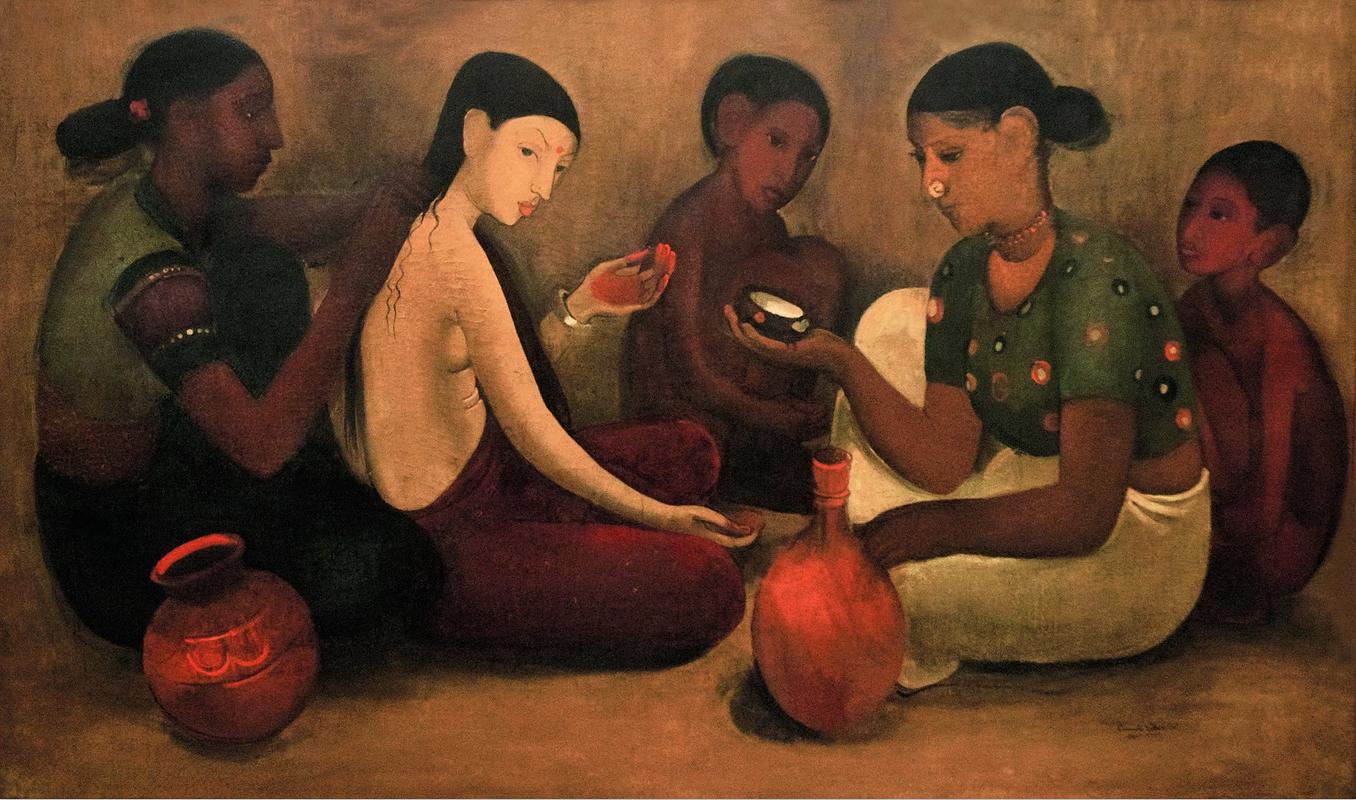More about Bride's Toilet
- All
- Info
- Shop

Contributor
These women look awfully glum about the ensuing wedding festivities….probably because this is an arranged marriage and neither the bride, nor the groom in the corresponding painting, Brahmacharis want to be together.
Nothing puts you down quite like being forced to marry someone you don’t love! This was Amrita Sher-Gil’s angle though. “Sher-Gil was enthralled by common people, their beauty, sadness and struggles.” A professor of hers in Paris “had often said that, judging by the richness of [her] colouring, [she] was not really in [her] element in the grey studios of the West, that [her] artistic personality would find its true atmosphere in the colour and light of the East.” Though this is at its core pretty racist, the professor was right. Sher-Gil was no longer inspired by the mundanity of Europe and headed to South India for inspiration. And inspiration she found!
During her travels, she came across the Ajanta Caves in Aurangabad district of Maharashtra and the Mogul miniatures of South India. She was forever touched by each of these styles but deeply depressed by the neglect of art by the Indian people. So she decided to light a fire in the artistic loins of India. She began to incorporate the frescos of the Ajanta Caves and the miniatures of the Moguls into her European training, resulting in works like Bride’s Toilet. Before her trip, her work was very Gauguin-ian but when she left Paris behind, she came into her own just in time for her to die an untimely death at the age of 28. Good thing she had already created a legendary body of work or else the world would have been robbed of her badassery.
Sources
- Kumar, Shikha. "A Life In Art". The Indian Express. N.p., 2014. Web. 6 July 2017.
- Richards, Melanie. "Badass Lady Creatives [In History]: Amrita Sher-Gil | Design Work Life". Design Work Life. N.p., 2014. Web. 6 July 2017.
Featured Content
Here is what Wikipedia says about Bride's Toilet
Bride's Toilet is an oil on canvas painting, painted by Hungarian-Indian artist Amrita Sher-Gil (1913–1941) in 1937.
A work of modernism, the painting draws influence from the frescoes of Ajanta and the miniatures of Mughal art, thereby resulting in a masterful amalgam of Indian and European styles. Part of Sher-Gil's well known South Indian trilogy, comprising also Brahmacharis and South Indian Villagers Going to Market, Bride's Toilet explores the simplicity and uniqueness of rural life, a recurring subject in her later paintings. When Sher-Gil returned to India in 1934, her approach towards art changed significantly. A number of later artworks revolved around the poor and the underprivileged, the commonfolk and their struggles.
Bride's Toilet depicts a bride's chamber, wherein a young light-skinned woman, presumably the titular bride, is seated. She is half-naked; her palms are covered in mehndi. She is surrounded by two other women and two children. One of the women is dressing her hair, and the other is holding a container. Their faces are expressionless. The painting employs a rich, colourful palette. Tones have been skilfully used. The painting demonstrates Sher-Gil's curious interest in women, their lives and adversities.
The painting was one of 33 of Sher-Gil's works displayed at her solo exhibition at Faletti's Hotel in Lahore, British India, held from 21 to 27 November 1937.
Check out the full Wikipedia article about Bride's Toilet













